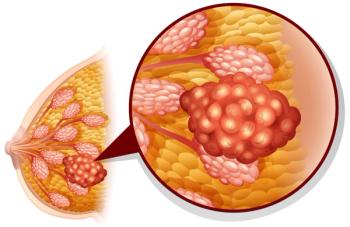
NDA for Parsaclisib Receives FDA Priority Review in MCL and MZL
The FDA granted priority review to a new drug application for parsaclisib in patients with mantle cell lymphoma and other non-Hodgkin lymphomas.
The FDA has accepted and granted priority review to a new drug application for parsaclisib (INCB050465) for patients with relapsed/refractory mantle cell lymphoma (MCL) and marginal zone lymphoma (MZL), according to a press release by developer Incyte. Additionally, an indication for follicular lymphoma is also under standard review.
The accepted application for the next-generation oral inhibitor of PI3Kδ comes from the results of several phase 2 studies including CITADEL-203 (NCT03126019), which examined the drug in follicular lymphoma; CITADEL-204 (NCT03144674) in MZL; and CITADEL-205 (NCT03235544) in MCL. As the priority review designation shortens the review period by 4 months vs the standard review process, the prescription drug user fee act of April 30, 2022 in MCL and MZL.
"Non-Hodgkin lymphomas are some of the most common cancers in the United States, and the FDA’s acceptance of this NDA [new drug application] represents an important milestone for Incyte and for non-Hodgkin lymphoma patients who have not responded to or who have progressed on initial therapies," Peter Langmuir, MD, group vice president of oncology targeted therapies at Incyte, said in a press release.
The primary end points for all 3 trials were objective response rate (ORR), with secondary end points including duration of response (DOR), progression-free survival (PFS), overall survival (OS), safety, and tolerability.
Results from the trials were presented at the
Patients who enrolled on the CITADEL-203 trial had follicular lymphoma of grade 1, 2, or 3a, who received at least 2 prior lines of systemic therapy, and had an ECOG performance status of less than 2, as well as being eligible for a hematopoietic stem cell transplant. Patients in the CITADEL-204 study had MZL and received at least 1 prior systemic therapy, including Bruton tyrosine kinase (BTK) inhibitors, had a radiological measurable lymphadenopathy or extra nodal lymphoid malignancy, and an ECOG performance status of less than 2. Those in the CITADEL-205 study had relapsed/refractory MCL and received 1 to 3 prior lines of systemic therapy and were either naïve to or previously treated with a BTK inhibitor. Patients enrolled on the trial also had an ECOG score of less than 2 and radiologically measurable lymphadenopathy or an extranodal lymphoid malignancy
Those who enrolled on the CITADEL-203 trial (n = 95) and were in the daily dosing group had an ORR of 75% (95% CI, 65%-83%), a median DOR of 14.7 months (95% CI, 12.0-17.5), and a median PFS of 15.8 months (95% CI, 13.8-19.1). Comparatively, the overall patient population of 118 patients had an ORR of 73% (95% CI, 64%-81%), a median DOR of 15.9 months (95% CI, 12.0–not evaluable [NE]), and a median PFS of 15.8 months (95% CI, 13.2-19.3).
In the CITADEL-204 study, 72 patients in the daily dosing group achieved an ORR of 56.9% (95% CI, 44.7%-68.6%). The median DOR (95% CI, 8.1-NE) and median PFS (11.0-NE) were not reached. In comparison, the overall population (n = 100) had an ORR of 57.0 months (95% CI, 46.7-66.9), a median DOR of 12.0 months (5% CI, 9.3-NE), and a median PFS of 19.4 (95% CI, 13.7-NE).
In the CITADEL-205 study, 77 patients who were BTK inhibitor naïve in the daily dosing group had an ORR of 71% (95% CI, 60%-81%), a median DOR of 9.0 months (95% CI, 6.1-14.7), and a median PFS of 11.1 months (95% CI, 8.3-NE). The median OS that was not reached. Those in the overall population (n = 108) had an ORR of 70% (95% CI, 61%-79%), a median DOR of 14.7 months (95% CI, 7.7-NE), and a median PFS of 11.1 months (95% CI, 8.3-19.2). The median OS that was not reached.
Additionally, those in the CITADEl-205 trial who were previously treated with ibrutinib (Imbruvica) in the daily dosing group (n = 41) had an ORR of 29% (95% CI, 16%-46%), a median DOR of 3.7 months (95% CI, 1.9-NE), a median PFS of 3.7 months (95% CI, 1.8-4.1), and a median OS of 11.2 months (7.9-NE). Additionally, those in the overall population (n = 53) had an ORR of 25% (95% CI, 14%-38%), a median DOR of 3.7 months (95% CI, 1.9-NE), a median PFS of 3.7 months (95% CI, 1.8-3.9), and a median OS of 11.2 months (95% CI, 7.9-17.1).
Parsaclisib has previously been granted priority review by the FDA for the treatment of relapsed or refractory MZL for those who have received at least 1 prior line of an anti–CD20-based regimen. It was also granted priority review for patients with MCL who have had at least 1 prior line of therapy.
Currently, confirmatory phase 3 studies being prepared to further assess the use of parsaclisib in patients with MCL (CITADEL-301), and relapsed or refractory follicular lymphoma and MZL (CITADEL-302).
References
1. Incyte announces acceptance of NDA for parsaclisib for three types of relapsed or refractory non-Hodgkin lymphomas. News Release. Incyte. November 1, 2021. Accessed November 1, 2021. https://yhoo.it/3w3rz05
2. Incyte announces parsaclisib treatment results in high rate of rapid and durable responses in patients with relapsed or refractory B-cell non-Hodgkin lymphomas. News Release. Incyte. December 7, 2020. Accessed November 1, 2021. https://bwnews.pr/3ECPgPI
Newsletter
Stay up to date on recent advances in the multidisciplinary approach to cancer.





















































































